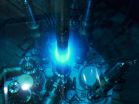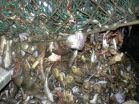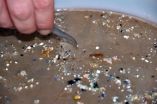(Press-News.org) Imagine the open ocean as a microbial megacity, teeming with life too small to be seen. In every drop of water, hundreds of types of bacteria can be found. Now scientists have discovered that communities of these ocean microbes have their own daily cycles—not unlike the residents of a bustling city who tend to wake up, commute, work, and eat at the same times.
What's more, it's not all about the sun. Light-loving photoautotrophs—bacteria that need solar energy to help them photosynthesize food from inorganic substances—have been known to sun themselves on a regular schedule. But in a new study published in the July 11 issue of the journal Science, researchers working at Station ALOHA, a deep ocean study site 100 km north of Oahu, observed different species of free-living, heterotrophic bacteria turning on diel cycling genes at slightly different times—suggesting a wave of transcriptional activity that passes through the microbial community each day.
"I like to say they are singing in harmony," said Edward F. DeLong, professor of Oceanography at University of Hawaii at Manoa and the head of the Massachusetts Institute of Technology team that made this discovery.
"For any given species, the gene transcripts for specific metabolic pathways turn on at the same time each day, which suggests a sort of temporal compartmentalization," said DeLong, who was the first scientist to be hired by the University under the auspices of the Hawai'i Innovation Initiative. "It's a biologically and biogeochemically relevant new result."
The observations were made possible by advanced microbial community RNA sequencing techniques, which allow for whole-genome profiling of multiple species at once. The work was a collaboration between the Monterey Bay Aquarium Research Institute and DeLong's team, who together employed a free-drifting robotic Environmental Sample Processor (ESP) as part of a Center for Microbial Oceanography: Research and Education (C-MORE) research cruise at Station ALOHA. Riding the same ocean currents as the microbes it follows, the ESP is uniquely equipped to harvest the samples needed for this high-frequency, time-resolved analysis of microbial community dynamics.
What scientists saw was intriguing: different species of bacteria expressing different types of genes in different, but consistent, cycles—turning on, for example, the type of restorative genes needed to rebuild their solar-collecting powers at night, then ramping up with different gene activity to build new proteins during the day. "The regularity and timing of individual microbial activities is somewhat like a new shift of hourly workers punching in and out of the clock, day after day," DeLong said.
The coordinated timing of gene firing across different species of ocean microbes could have important implications for energy transformation in the sea. Marine microbes are critically linked to ocean health and productivity. The mechanisms that regulate this periodicity remain to be determined.
But can you set your watch to it? DeLong says you can, but it matters whether you're tracking the bacteria in the lab or out at sea. For example, maximal light levels at 23 meters depth at Station ALOHA were twice as high as light conditions that were previously used in experimental settings in the laboratory—which may have an effect on microbe activity and daily cycles. That's part of why it's so important to conduct this research in the actual open ocean environment.
This study was funded in part by the National Science Foundation and by a grant from the Gordon and Betty Moore Foundation [Grant GBMF3777]. Separately, in 2013, the Moore Foundation's national Marine Microbiology Initiative awarded DeLong and UH Manoa professor David Karl $4.2 million to explore how the trillions of microscopic organisms at the base of the ocean's food webs interact with each other and the environment.
DeLong aims to continue his groundbreaking in situ ocean research with support from the Moore Foundation and as co-director of the new Simons Collaboration on Ocean Processes and Ecology (SCOPE), a five-year $40 million collaboration funded by the largest private gift in UH history.
"There are some fundamental laws to be learned about how organisms interact, to make the system work better as a whole and be more efficient," DeLong said. "At its base, that's one of the main things we're after in SCOPE—these fundamental principles that make ecosystems work. These findings have tremendous applications in all sorts of arenas."
INFORMATION:
Citation:
Elizabeth A. Ottesen, Curtis R. Young, Scott M. Gifford, John M. Eppley, Roman Marin III, Stephan C. Schuster, Christopher A. Scholin, and Edward F. DeLong. "Multispecies diel transcriptional oscillations in open ocean heterotrophic bacterial assemblages." Science. 11 July 2014.
About the Environmental Sample Processor (ESP):
Development and applications of the MBARI ESP were made possible with funding from National Science Foundation Grant OCE-0314222 (to C.A.S.), National Aeronautics and Space Administration Astrobiology Grants NNG06GB34G and NNX09AB78G (to C.A.S.), the Gordon and Betty Moore Foundation (#2728; C.A.S.), and the David and Lucile Packard Foundation. http://www.mbari.org/esp/
About the School of Ocean and Earth Science and Technology
The School of Ocean and Earth Science and Technology at the University of Hawaii at Manoa was established by the Board of Regents of the University of Hawaii in 1988 in recognition of the need to realign and further strengthen the excellent education and research resources available within the University. SOEST brings together four academic departments, three research institutes, several federal cooperative programs, and support facilities of the highest quality in the nation to meet challenges in the ocean, earth and planetary sciences and technologies. http://www.soest.hawaii.edu/
About the Hawaii Innovation Initiative
The University of Hawaii is working in partnership with the private sector and government to build a thriving research enterprise in Hawaii that will develop a third major economic sector for the State, create high-quality living-wage jobs, and address the challenges and opportunities that face our communities and the world to improve our quality of life. More information about the Hawaii Innovation Initiative is available online at http://hawaii.edu/innovation.
New research finds ocean's most abundant organisms have clear daily cycles
Coordinated timing may have implications for energy transformation, ocean food web
2014-07-10
ELSE PRESS RELEASES FROM THIS DATE:
Window of opportunity against HIV comes from 'fitness bottleneck'
2014-07-10
New research on HIV transmission shows that viral fitness is an important basis of a "genetic bottleneck" imposed every time a new person is infected. The findings define a window of opportunity for drugs or vaccines to prevent or limit infection.
HIV represents evolution on overdrive. Every infected individual contains a swarm of viruses that exhibit variability in their RNA sequence, and new mutations are constantly appearing. Yet nearly every time someone new is infected, this diverse population of viruses gets squeezed down to just one individual.
The genetic bottleneck ...
Study points to potential new target for antibiotics against E. coli, other bugs
2014-07-10
COLUMBUS, Ohio – Scientists have identified a protein that is essential to the survival of E. coli bacteria, and consider the protein a potential new target for antibiotics.
In the study, the researchers confirmed that this protein, called MurJ, flips a fatty molecule from one side of a bacterial cell membrane to the other. If that molecule isn't flipped, the cell cannot construct a critical layer that keeps pressurized contents of the cell contained. If those contents aren't contained, the cell bursts.
E. coli is part of the gram-negative family of bacteria, characterized ...
Cultured CTCs reveal genetic profile, potential drug susceptibility of breast cancer cells
2014-07-10
Circulating tumor cells captured with a microchip-based device developed at the Massachusetts General Hospital (MGH) Center for Engineering in Medicine and the MGH Cancer Center can be cultured to establish cell lines for genetic analysis and drug testing. In the July 11 issue of Science, an MGH research team reports that the cultured cells accurately reflect a tumor's genetic mutation over time and changing susceptibility to therapeutic drugs.
"We now can culture cells from the blood that represent those present in metastatic deposits, which allows testing for drug ...
Inherited 'memory' of environmental impact on health may be limited
2014-07-10
When a pregnant mother is undernourished, her child is at a greater than average risk of developing obesity and type 2 diabetes, in part due to so-called 'epigenetic' effects. A new study in mice demonstrates that this 'memory' of nutrition during pregnancy can be passed through sperm of male offspring to the next generation, increasing risk of disease for her grandchildren as well. In other words, to adapt an old maxim, 'you are what your grandmother ate'. The study also raises questions over how epigenetic effects are passed down from one generation to the next – and ...
Researchers harness a powerful new source of up-to-date information on economic activity
2014-07-10
ANN ARBOR--- Researchers at the University of Michigan, University of California Berkeley, and Arizona State University have developed a new data infrastructure for measuring economic activity.
The infrastructure uses aggregated and de-identified data on transactions and account balances from Check, a mobile payments app, to produce accurate and comprehensive measures of consumers' spending and income on a daily basis.
In a paper appearing in the July 11 issue of Science, economists Michael Gelman, Shachar Kariv, Matthew Shapiro, Dan Silverman, and Steven Tadelis ...
International science team solve biological mystery
2014-07-10
This news release is available in German.
An international team of researchers, led by the University of Leicester, has solved a long-standing mystery in biology, by identifying the molecular structure of a vital biological chemical. The debate – which has raged within the scientific community for years – boils down to something as simple as a hydrogen atom: is it there, or is it not?
The controversy centres around a form of enzyme called a heme (or haem, as in haemoglobin) at the centre of which is an iron atom (Fe) called a 'ferryl' which becomes oxidised when ...
Overfishing in the English Channel leaves fisherman scraping the bottom of the barrel
2014-07-10
Decades of overfishing in the English Channel has resulted in the removal of many top predators from the sea and left fishermen 'scraping the barrel' for increasing amounts of shellfish to make up their catch.
Sharks, rays, cod, haddock and many other species at the head of the food chain are at historic lows with many removed from the area completely.
These are some of the findings of a study led by marine biologists at Plymouth University, in association with international non-profit research organization WorldFish. They analysed catches over the past 90 years and found ...
Uncertainty gives scientists new confidence in search for novel materials
2014-07-10
Scientists at Stanford University and the Department of Energy's SLAC National Accelerator Laboratory have found a way to estimate uncertainties in computer calculations that are widely used to speed the search for new materials for industry, electronics, energy, drug design and a host of other applications. The technique, reported in the July 11 issue of Science, should quickly be adopted in studies that produce some 30,000 scientific papers per year.
"Over the past 10 years our ability to calculate the properties of materials and chemicals, such as reactivity and mechanical ...
Scripps scientists discover evidence of super-fast deep earthquake
2014-07-10
As scientists learn more about earthquakes that rupture at fault zones near the planet's surface—and the mechanisms that trigger them—an even more intriguing earthquake mystery lies deeper in the planet.
Scientists at Scripps Institution of Oceanography at UC San Diego have discovered the first evidence that deep earthquakes, those breaking at more than 400 kilometers (250 miles) below Earth's surface, can rupture much faster than ordinary earthquakes. The finding gives seismologists new clues about the forces behind deep earthquakes as well as fast-breaking earthquakes ...
Leading scientists express rising concern about 'microplastics' in the ocean
2014-07-10
Microplastics – microscopic particles of plastic debris – are of increasing concern because of their widespread presence in the oceans and the potential physical and toxicological risks they pose to organisms.
This is the view of two of the world's most eminent authorities on the subject, Professor Kara Lavender Law, of Sea Education Association (Woods Hole, MA), and Professor Richard Thompson of Plymouth University (UK).
In an article published today in the journal Science, the two scientists have called for urgent action to "turn off the tap" and divert plastic waste ...
LAST 30 PRESS RELEASES:
Anthropologists offer new evidence of bipedalism in long-debated fossil discovery
Safer receipt paper from wood
Dosage-sensitive genes suggest no whole-genome duplications in ancestral angiosperm
First ancient human herpesvirus genomes document their deep history with humans
Why Some Bacteria Survive Antibiotics and How to Stop Them - New study reveals that bacteria can survive antibiotic treatment through two fundamentally different “shutdown modes”
UCLA study links scar healing to dangerous placenta condition
CHANGE-seq-BE finds off-target changes in the genome from base editors
The Journal of Nuclear Medicine Ahead-of-Print Tip Sheet: January 2, 2026
Delayed or absent first dose of measles, mumps, and rubella vaccination
Trends in US preterm birth rates by household income and race and ethnicity
Study identifies potential biomarker linked to progression and brain inflammation in multiple sclerosis
Many mothers in Norway do not show up for postnatal check-ups
Researchers want to find out why quick clay is so unstable
Superradiant spins show teamwork at the quantum scale
Cleveland Clinic Research links tumor bacteria to immunotherapy resistance in head and neck cancer
First Editorial of 2026: Resisting AI slop
Joint ground- and space-based observations reveal Saturn-mass rogue planet
Inheritable genetic variant offers protection against blood cancer risk and progression
Pigs settled Pacific islands alongside early human voyagers
A Coral reef’s daily pulse reshapes microbes in surrounding waters
EAST Tokamak experiments exceed plasma density limit, offering new approach to fusion ignition
Groundbreaking discovery reveals Africa’s oldest cremation pyre and complex ritual practices
First breathing ‘lung-on-chip’ developed using genetically identical cells
How people moved pigs across the Pacific
Interaction of climate change and human activity and its impact on plant diversity in Qinghai-Tibet plateau
From addressing uncertainty to national strategy: an interpretation of Professor Lim Siong Guan’s views
Clinical trials on AI language model use in digestive healthcare
Scientists improve robotic visual–inertial trajectory localization accuracy using cross-modal interaction and selection techniques
Correlation between cancer cachexia and immune-related adverse events in HCC
Human adipose tissue: a new source for functional organoids
[Press-News.org] New research finds ocean's most abundant organisms have clear daily cyclesCoordinated timing may have implications for energy transformation, ocean food web


